ASUS UL80Vt First Look: Mobility Redefined
by Jarred Walton on October 24, 2009 8:00 PM EST- Posted in
- Laptops
ASUS UL80Vt Benchmarked - General Performance
This is a first look and we have not yet had a chance to run all of our performance tests. Battery life testing in particular is going to take a long time -- which is a good thing, outside of the testing aspect. We have only had the UL80Vt for two days now, but we have been duly impressed with its features, design, and performance. It may not be the best-looking laptop on the planet, it may not have every feature under the sun, and it certainly isn't the fastest laptop. However, it does everything a typical laptop user could need, it does it at an affordable price point, and it truly manages to redefine what we can expect in terms of mobility from Windows laptops. Here are a few preliminary benchmarks we've run.
We conducted tests using the "moderate battery saving" and "maximum performance" profiles in ASUS' Power4Gear software. Turbo mode (overclocking) was enabled in all testing so far; honestly, we don't see much point in disabling it (which requires a reboot), but we'll test battery life without Turbo mode for the full review; that may add another 5-10% battery life, although the laptop already lasts a full day so it's not a critical concern. The SU7300 CPU has two P-states, 800MHz and 1300MHz; the overclocked FSB results in the SU7300 running at 1066MHz or 1733MHz (using a 4X or 6.5X multiplier). CPU-Z does not report clock speeds correctly (it always showed an 8X multiplier for some reason), but ASUS provided an updated version of Intel's Thermal Analysis Tool that reports the correct speed.
After a few initial tests, we discovered that the only way to get the CPU to run at the 6.5X multiplier is to select "Maximum Performance" in the Power4Gear software, with the maximum CPU speed set to at least 62%; otherwise the CPU will always run at the 4X multiplier. Since we already had a bunch of results for 1066MHz, we decided to report those -- it will make for an interesting comparison with the Intel Atom at least. The 1733MHz results will be in bright green and the 1066MHz results are in dark green in the following charts. We'll start with general performance results using PCMark as well as a few CPU intensive tasks like video encoding and 3D rendering.
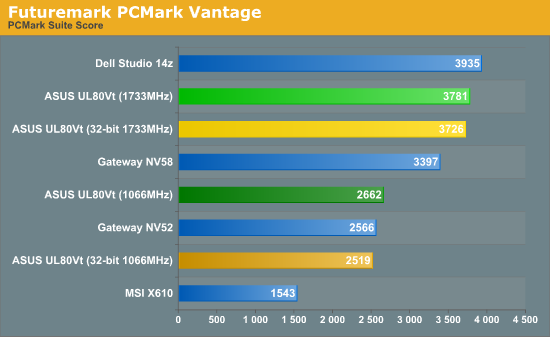
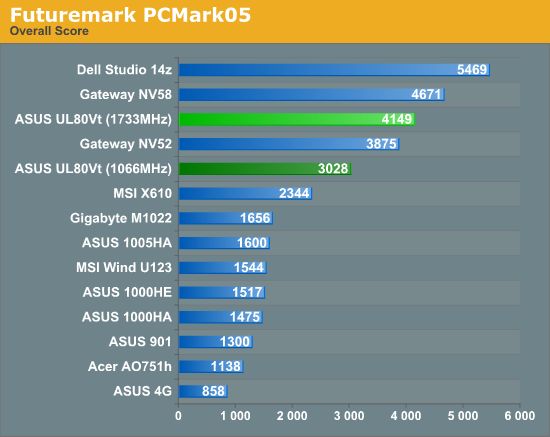
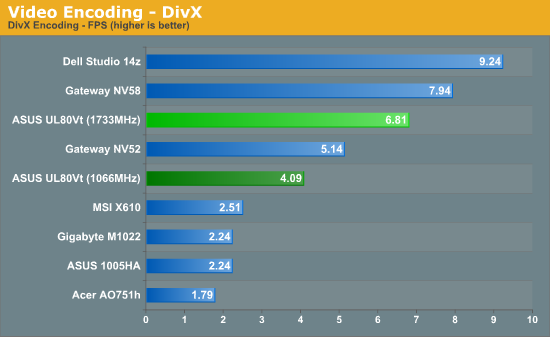

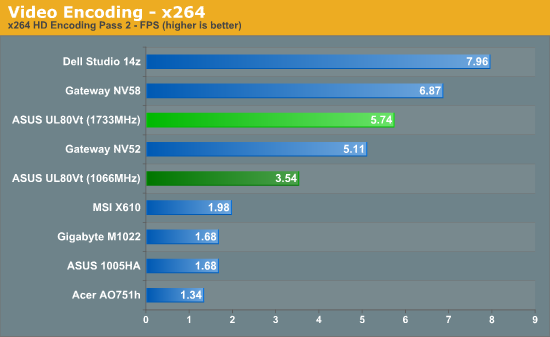
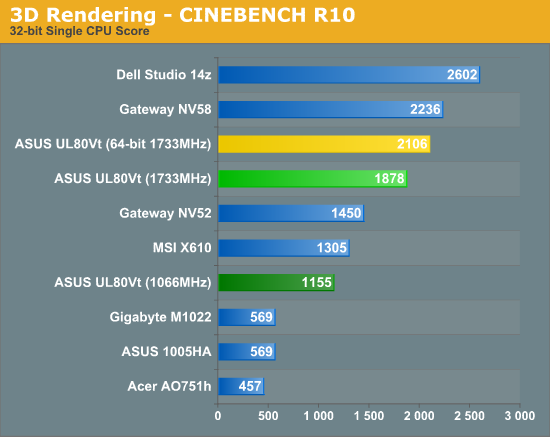
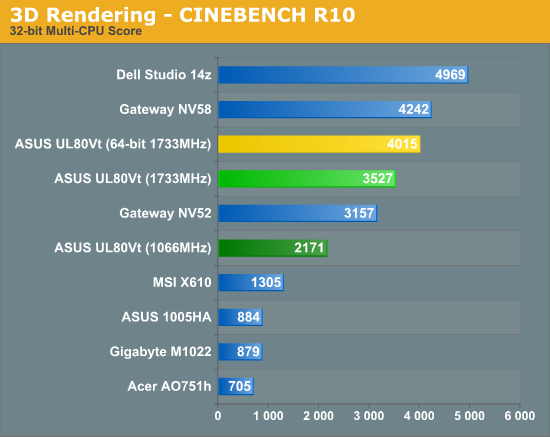
The general performance delivered by the UL80Vt is certainly impressive. It's not the fastest laptop on the market by any means, but application performance is better than the majority of AMD-based laptops currently available. The overclocked SU7300 outperforms the Athlon QL-64 (2.1GHz) by 7% in PCMark05, 47% in PCMark Vantage, 12% in the second x264 encoding pass (the first pass is relatively simple by comparison, depending more on the hard drive and platform than on the CPU), 32% in DivX encoding, and 12% in CINEBENCH R10. The latest 45nm AMD parts like the Turion II Ultra M640 will regain the lead, certainly, but we still have to account for power draw. We'll get to that in a moment, but suffice it to say that it's going to be difficult to beat the overclocked SU7300.
Comparing the UL80Vt to netbooks shows just how slow the Intel Atom is. Even at 1066MHz, the UL80Vt is typically at least twice as fast as the ASUS 1005HA, and at 1733MHz it's 150-250% faster. Sure, it also costs twice as much, but we would make a strong argument that netbooks are only "fast enough" if your demands are low. The bigger selling point for netbooks is their small size and weight, and 14" laptops costing close to $800 certainly encroach on that territory. Netbooks work far better as a second (or third…) PC than as your primary system, while something like the UL80Vt can fill all roles reasonably well. If the general application performance makes netbooks look bad, wait until we look at graphics performance.










100 Comments
View All Comments
7Enigma - Monday, October 26, 2009 - link
I'll do it for you. Using an old review from April09 where they posted the min/WHr:MacBook2008 got a 6.36
Asus gets a 6.32 (531min / 84 WHr)
It is important however to note if the testing methodology (ie websites used/etc.) have changed significantly since the 2008 Macbook review and if so in which direction (my guess would be more draining now).
If they are directly (or closely) comparible then you have to factor in weight difference and price, and of course CPU/GPU performance differences. Since the price is $150 cheaper, the weight difference IMO would have to be significantly lighter for the MacBook to justify (build-quality, OS, intangibles aside).
JarredWalton - Monday, October 26, 2009 - link
All I know for certain is that the old results had Apple at 6.36 (as mentioned), but the tests are not the same as the ones I used for the Windows laptops. Anand has the new Internet tests I'm using (I ran them on Linux, so they should run fine on OS X), so when he's had a chance to run numbers we can make the comparison. The UL80Vt is twice the relative battery life of most Windows laptops, and over three times the relative battery life of higher-spec units. I can't say for certain whether it has matched or surpassed the latest MacBook, but it should be very close if not better.Pirks - Monday, October 26, 2009 - link
"32% in DivX encoding, and xxx% in CINEBENCH R10"xxx%? Really?! Are you hiding something from us Jarred? ;)))
JarredWalton - Monday, October 26, 2009 - link
LOL... sorry, I was still running tests at the time and obviously missed that. It's 12% BTW; text updated.mczak - Sunday, October 25, 2009 - link
I'm wondering why asus uses a overclocked ULV chip. Presumably they increase voltage a bit when overclocked to guarantee stable operation right? So in this case power should be very similar to LV chips (+30% for higher clock plus something additional for more voltage - ULV chips are 10W, LV 17W). So why not get a non-overclocked LV chip like the SL9600 in the first place? 2.133Ghz, 6MB cache, should cost about the same as the SU7300.JarredWalton - Sunday, October 25, 2009 - link
CPU-Z reports the voltage as 0.875V -- at the overclocked 1.73GHz setting. The ULV parts are essentially CPUs that work well with very low voltages, and they usually have better overclocking headroom. Anyway, it appears that even overclocked, the SU7300 isn't consuming more than perhaps 12-13W. (I'll have to do more testing to verify that figure for the full review.) When you have a laptop that uses 9.5W on average for Internet surfing, an extra 3W is a big deal.mczak - Monday, October 26, 2009 - link
Those 0.875V are presumably at idle? Would be way below published VID range under load (hopefully cpu-z reports this correctly even for mobile cpus).I just doubt a ULV chip is really any better if you overclock it to the level of a LV chip. Unless you're courageous and don't overvolt it to the same level, though you could just undervolt a LV chip instead...
In any case, I'd be very interested in the voltage adjustments (if any) under idle/load for OC/-nonOC setting - of course those chips have a VID range and hence could vary by chip but in practice they don't vary that much and the asus overclocking would presumably add a fixed voltage increase (if any).
mschira - Sunday, October 25, 2009 - link
Amazing, the most interesting new laptops at the moment are all cheap ones.Like the acer Timelines, the Asus"WTF have they been thinking with that name", the Dell Studio 14z etc.
They are all very nice, but they have compromises to keep em cheap. Not too bad compromises, but still.
Why doesn't Asus make a Lambougini version of this little nice buddy? Ditch the CD drive - who needs those - give us a nice screen, give us an expensive light, great case.
I'll happily pay the premium - it's not going to be that much anyway.
M.
KikassAssassin - Sunday, October 25, 2009 - link
Wow, with the exception of the screen, this thing is almost exactly what I've been looking for in a laptop. I've been really disappointed in the seeming non-existence of an affordable, highly-portable laptop with a dual-core ULV processor, non-Intel graphics, and a high-Wh battery. Put a high-quality display with a matte overlay (WhyTF is almost every laptop using freaking glossy nowadays?), and a toggle-able back-lit keyboard on this thing, and it would be my perfect laptop to a T.I also really like the idea of the ability to toggle between low-power integrated graphics and higher-performing discreet graphics, and I wish more laptops would include this feature. I have a feeling nVidia's going to be pushing hard for this once Arrandale comes out.
hybrid2d4x4 - Sunday, October 25, 2009 - link
One request for the game testing section: add an older title s/a Half-life 2 in addition to the usual new new games. I'm more interested in what it can run than the obvious "well, there you have it- it won't run the latest titles, get a desktop for that".Looking forward to the review!!